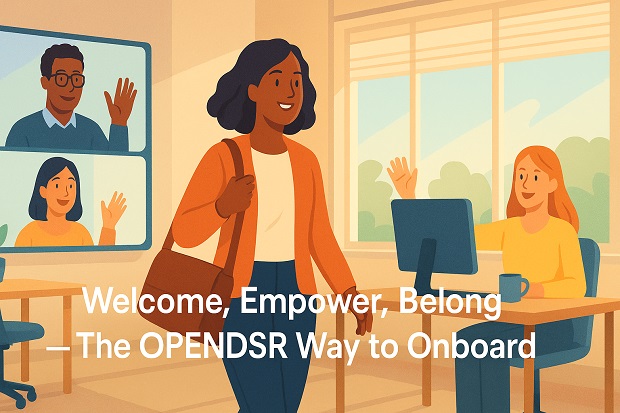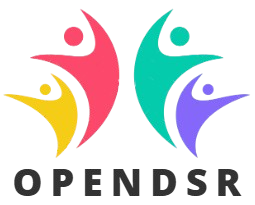
Building Better Onboarding with OPENDSR: Designing First Impressions That Last
The Moment That Shapes Everything
A new hire’s first day is more than paperwork and orientation — it’s the moment your organization makes its first emotional promise.
Every company wants engaged employees, but that engagement begins before the first login.
Before the first meeting invite.
Before the first “Welcome aboard” email.
Yet, many onboarding experiences fail at the very thing they were meant to do — make employees feel prepared, included, and inspired.
Research from the Society for Human Resource Management (SHRM) shows that one in three new employees decide whether they’ll stay within their first 90 days.
The reason isn’t always compensation or workload — it’s experience.
“Onboarding is not orientation. It’s your organization’s first act of culture design.”
— OPENDSR Framework Principle
That’s why OPENDSR treats onboarding not as an HR process, but as a designed journey — one that blends empathy, design standards, and real-time feedback.
Why Traditional Onboarding Falls Short
In many organizations, onboarding is still seen as a checklist:
- Fill forms ✅
- Attend orientation ✅
- Get laptop & login ✅
- Meet your manager ✅
By Day 3, the emotional energy fades. The excitement that brought the employee in starts to blend into confusion and fatigue.
The friction points are familiar:
- Too much information, too fast.
- Unclear ownership between HR, IT, and managers.
- Lack of social integration.
- Feedback loops that start only after something goes wrong.
The result? A new hire who knows what to do, but not why it matters — or who they belong with.
That’s where OPENDSR changes the script.
💡 How OPENDSR Reinvents Onboarding
OPENDSR stands for Operating Principles for Empathy-led Navigation, Design Standards, and Real-time Intelligence.
It gives organizations a practical 7-step framework to design onboarding experiences that are structured, human, and continuously improving.
🧭 The 7-Step OPENDSR Cycle Applied to Onboarding
Step
What It Means for Onboarding
Observe 👀
Understand how new hires actually experience onboarding — not just how HR plans it.
Prioritize 🎯
Identify which friction points matter most: confusion, delays, lack of connection.
Envision 🧠
Co-create a better onboarding journey with new hires and recent alumni.
Navigate 🗺️
Design a clear roadmap — Day 0 to Day 90 — with defined touchpoints.
Design ✏️
Create templates, guides, and rituals that make onboarding feel consistent and human.
Systematize ⚙️
Embed the new experience into systems like SharePoint, Teams, or HRIS.
Refine 🔄
Gather feedback in real-time and continuously evolve the experience.
Step 1: Observe – Seeing the Real First-Day Experience
The first step is listening deeply to what new hires feel — not just what they do.
Through empathy interviews, pulse check-ins, and experience journaling, organizations can capture real onboarding moments:
- “I got my laptop, but no one told me who to ask for access.”
- “I wasn’t sure what success looked like in my first week.”
- “My buddy was busy; I felt awkward reaching out.”
OPENDSR helps teams visualize these insights using Journey Maps, which show emotional highs and lows across the onboarding timeline.
These observations reveal where structure is missing, or where empathy must be designed in.
Step 2: Prioritize – Fixing What Hurts Most
After observing, not every issue can be solved at once.
OPENDSR’s Prioritize phase introduces the Friction Matrix — ranking issues by:
- Impact on employee confidence
- Frequency across new hires
- Ease of fixing
For example:
- Complex access permissions might cause 70% of frustration.
- Buddy engagement may be inconsistent but easily fixed.
A simple workshop with recent hires can quickly highlight top priorities.
The rule: Start where friction is felt the most and trust can be rebuilt fastest.
Step 3: Envision – Designing Emotional Journeys
Once priorities are clear, the next move is imagination — co-creating what “great onboarding” could feel like.
Teams use Experience Co-Design Sessions with:
- HR
- Managers
- IT support
- New hires
Together, they define moments that matter:
- Welcome moment: How do we say “we’re glad you’re here”?
- Connection moment: Who helps them feel they belong?
- Purpose moment: When do they understand why their role matters?
These moments are mapped into a redesigned Onboarding Experience Blueprint, aligning technology, people, and emotion.
Step 4: Navigate – From Idea to Plan
Good ideas need clear navigation to become habits.
In OPENDSR’s Navigate phase, HR and team leads build a Day 0–Day 90 Roadmap that integrates:
- Touchpoints: Emails, meetings, milestones.
- Owners: HR, Manager, Buddy, IT, Peer Group.
- Systems: Where each moment lives — SharePoint, Slack, Teams, etc.
Example roadmap:
- Day 0: Welcome kit email + intro video from CEO.
- Day 3: Buddy check-in + access setup confirmation.
- Week 2: Mini “EX Sprint Review” — how’s it going?
- Day 45: Manager 1:1 — role clarity & learning plan.
- Day 90: “Graduation moment” — recognition and reflection.
With clear navigation, onboarding transforms from scattered events into a guided journey.
Step 5: Design – Creating Consistency and Warmth
Now comes the creative heart of OPENDSR — Design Standards.
Design in onboarding means creating repeatable rituals that make every experience consistently human:
- Standardized welcome messages from managers.
- Buddy guidelines focused on inclusion.
- Visual “Role Cards” explaining purpose and first goals.
- Personalized dashboards for new hires showing milestones and progress.
This step ensures every new employee — remote or on-site — gets a similar emotional and practical start.
“Consistency is kindness. Design removes guesswork from empathy.”
Step 6: Systematize – Automating Connection
Great onboarding doesn’t rely on memory — it’s built into systems.
In OPENDSR’s Systematize phase, automation tools help deliver consistent experience touchpoints:
- Automated welcome workflows in Microsoft Teams or Slack.
- Integration with HRIS for timely reminders (buddy check-ins, surveys).
- Smart nudges for managers: “Your new hire’s first Friday — drop a note!”
- Micro feedback loops triggered at each milestone.
These automations don’t replace human warmth — they make space for it.
Step 7: Refine – Turning Feedback into Evolution
Onboarding should evolve with every cohort.
In the Refine phase, OPENDSR introduces Experience Review Loops — short, focused reflections:
- Weekly micro-surveys on clarity and confidence.
- Quarterly onboarding retros with recent hires.
- Experience dashboards showing “Onboarding Health” metrics.
This continuous loop ensures onboarding stays alive, not static.
“Every new employee is a live test of your culture design.”
Over time, this turns onboarding into a self-improving system — where each experience teaches the next.
Case Example: Redesigning Onboarding in a Hybrid Tech Firm
A 3,000-employee software company implemented OPENDSR to address high first-year turnover (18%).
Step-by-Step Impact:
- Observe: Journey mapping revealed biggest friction — unclear expectations in first 30 days.
- Prioritize: Focused on manager connection and purpose alignment.
- Envision: Co-created “First 45” experience map with input from engineers and HR.
- Navigate: Built digital roadmap embedded in Microsoft Teams.
- Design: Created standard role cards + personalized dashboards.
- Systematize: Integrated reminders in HRMS to automate check-ins.
- Refine: Added quarterly onboarding sentiment review.
Results after 6 months:
- 25% reduction in early attrition.
- 40% increase in “Clarity of Role” survey score.
- 33% higher satisfaction with onboarding.
- Faster time-to-performance (reduced by 20%).
What Employees Say
“My onboarding felt like a guided experience — not just a to-do list.”
— New Software Engineer
“The buddy system became a real friendship. It wasn’t forced.”
— Analyst, Finance Division
“The first 90 days used to feel overwhelming. Now it’s structured and personal.”
— Project Manager, IT
These testimonials capture the essence of OPENDSR onboarding: a system that feels personal because it’s designed to be human.
The Measurable Impact of OPENDSR Onboarding
Metric
Typical Improvement After 6–9 Months
Time to Productivity
↓ 20–30%
Early Attrition (0–6 months)
↓ 25–40%
Manager Check-in Compliance
↑ 50%
Engagement in First 90 Days
↑ 35%
Employee Satisfaction
↑ 40%
Referral Rate (from new hires)
↑ 22%
OPENDSR converts onboarding from a soft-intent process into a measurable experience driver.
Integrating OPENDSR Onboarding into Digital Workplaces
OPENDSR easily integrates with existing digital ecosystems like:
- SharePoint / CorporateOne: Host onboarding journeys, documents, and dashboards.
- Microsoft Teams: Deliver nudges, chats, and buddy match notifications.
- HRMS / ATS: Automate onboarding workflows and data updates.
- Slack: Enable real-time emotional pulse check-ins.
This makes onboarding native to work, not an extra task.
Platforms like CorporateOne, built on OPENDSR principles, already include “Onboarding Journeys,” “Role Cards,” and “Refinement Dashboards,” bringing empathy-led onboarding into daily workflow.
First Impressions Are Cultural Infrastructure
Onboarding isn’t a formality. It’s the foundation of experience.
Every moment — from the first email to the first project — tells the employee who you are as a company.
If those moments feel designed, connected, and caring, you build not just retention — you build trust.
OPENDSR helps organizations turn onboarding into a living, breathing system that:
- Listens through empathy.
- Acts through design.
- Sustains through feedback.
That’s how first impressions become lasting commitments.
“Great cultures don’t happen by accident — they’re onboarded, one experience at a time.”








